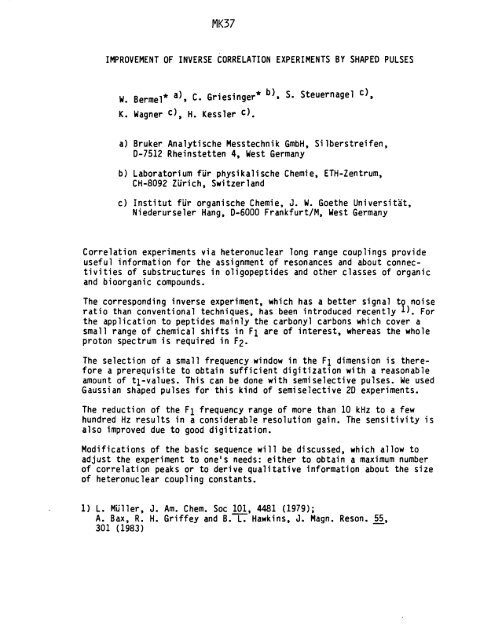th - 1987 - 51st ENC Conference
th - 1987 - 51st ENC Conference
th - 1987 - 51st ENC Conference
Create successful ePaper yourself
Turn your PDF publications into a flip-book with our unique Google optimized e-Paper software.
MK37<br />
IMPROVEMENT OF INVERSE CORRELATION EXPERIMENTS BY SHAPED PULSES<br />
W. Bermel* a), C. Griesinger* b) , S. Steuernagel c),<br />
K. Wagner c), H. Kessler c).<br />
a) Bruker Analytische Messtechnik GmbH, Silberstreifen,<br />
D-7512 Rheinstetten 4, West Germany<br />
b) Laboratorium fur physikalische Chemie, ETH-Zentrum,<br />
CH-8Og2 ZUrich, Switzerland<br />
c) Institut fur organische Chemie, J. W. Goe<strong>th</strong>e Universit~t,<br />
Niederurseler Hang, D-6000 Frankfurt/M, West Germany<br />
Correlation experiments via heteronuclear long range couplings provide<br />
useful information for <strong>th</strong>e assignment of resonances and about connec-<br />
tivities of substructures in oligopeptides and o<strong>th</strong>er classes of organic<br />
and bioorganic compounds.<br />
The corresponding inverse experiment, which has a better signal to noise<br />
ratio <strong>th</strong>an conventional techniques, has been introduced recently 1). For<br />
<strong>th</strong>e application to peptides mainly <strong>th</strong>e carbonyl carbons which cover a<br />
small range of chemical shifts in F 1 are of interest, whereas <strong>th</strong>e whole<br />
proton spectrum is required in F 2.<br />
The selection of a small frequency window in <strong>th</strong>e F 1 dimension is <strong>th</strong>ere-<br />
fore a prerequisite to obtain sufficient digitization wi<strong>th</strong> a reasonable<br />
amount of tl-values. This can be done wi<strong>th</strong> semiselective pulses. We used<br />
Gaussian shaped pulses for <strong>th</strong>is kind of semiselective 2D experiments.<br />
The reduction of <strong>th</strong>e F 1 frequency range of more <strong>th</strong>an 10 kHz to a few<br />
hundred Hz results in a considerable resolution gain. The sensitivity is<br />
also improved due to good digitization.<br />
Modifications of <strong>th</strong>e basic sequence will be discussed, which allow to<br />
adjust <strong>th</strong>e experiment to one's needs: ei<strong>th</strong>er to obtain a maximum number<br />
of correlation peaks or to derive qualitative information about <strong>th</strong>e size<br />
of heteronuclear coupling constants.<br />
1) L. MUller, J. Am. Chem. Soc 101, 4481 (1979);<br />
A. Bax, R. H. Griffey and B. L. Hawkins, J. Magn. Reson. 55,<br />
301 (1983)













